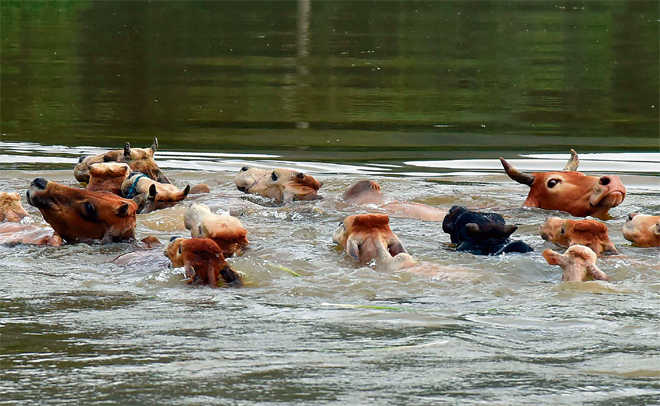
Needed: Rescue and relief of disaster-hit animals. AFP
KM Singh
Founder-Member, National Disaster Management Authority
The verdict of the Uttarakhand High Court on July 4 in a petition filed for the protection and welfare of animals is landmark. It mentions that animals throughout the state should be treated as "legal entities having a distinct persona with corresponding rights, duties and liabilities of a living person."
The 2013 floods in Uttarakhand caused a huge loss of human lives and animal wealth. At that time, the authorities geared up all possible resources for the evacuation, rescue and relief of human beings. But, no significant initiative was taken for the rescue and relief of animals as the departments concerned in the state were neither equipped nor prepared for the same.
This historic judgment should be an eye-opener to the government agencies for an introspection regarding their preparedness to deal with management of animals in all three phases of disaster. The administration should appreciate the spirit behind this order and plan a holistic approach towards the safety and protection of animals.
According to a report of the National Disaster Management Authority (NDMA), on an average, 94,830 animals perish in floods alone every year in our country. This does not take into account the loss of animal lives in other disasters which, by and large, remain unreported.
This subject of rescue and relief of animals in disasters has not been integrated in the overall disaster management framework of the country. It explains the lack of requisite preparedness, including an effective response mechanism for the rescue and relief of animals in disasters, as was seen in Uttarakhand in 2013. Significantly, the Disaster Management Act, 2005, which aims at a holistic approach to disaster management is focussed primarily on the safety and security of human beings and property and has no reference to the safety and security of animals. As a result, Animal Husbandry Departments at the Centre and states are not involved in any structured manner in the overall disaster management framework, except in the case of a drought. However, certain initiatives have been taken where a few states have responded positively.
In an agrarian society like India, around 70 per cent of the rural population directly depends on animal wealth for its livelihood. As such, this issue deserves priority attention. A study by the World Animal Protection (WAP) in 2012 identified three key gaps in the management of animals: inadequate training facilities and infrastructure, inadequate trained human resource and non-availability of any preparedness plan for the management of animals in disasters.
This issue assumes greater salience in the wake of emphasis given on livelihood protection in the Sendai Framework of Disaster Risk Reduction (2015-30). Section 30 (p) of the Sendai Framework focuses on strengthening the protection of livelihood and productive assets, including livestock and working animals.
Against this backdrop, the Policy Perspectives Foundation (PPF), a Delhi-based civil society organisation, and WAP have taken a number of initiatives in collaboration with the Animal Husbandry Department, GoI. These include organising a national workshop on the management of animals in emergencies (March 2016) in which the National Disaster Management Plan for management of animals in emergencies was released. India, incidentally, acquired the distinction of being the first country to prepare a national plan. The workshop made recommendations relating to the strengthening of the legal and institutional framework for protecting animals from disasters and the management of animals during all three stages of disaster.
To address the issue of non-availability of trained human resources, the PPF and WAP collaborated with the National Disaster Response Force (NDRF) and the Bihar State Disaster Management Authority (SDMA) to train their responders in a structured manner. These programmes were aimed at developing the capacity of the personnel in efficiently rescuing animals during disasters, providing first aid to animals and also conducting community awareness generation programmes for cattle owners in vulnerable areas.
The Bihar SDMA has taken pioneering initiatives in this field in terms of incorporating an exclusive chapter on resilient villages with livestock and livelihood in the Bihar State Disaster Risk Reduction (2015-30) Plan on the lines of the Sendai Framework. To achieve this objective, Bihar has launched a comprehensive plan for training all veterinarians (approxmately 1,000) in the state. It is necessary that other states also emulate such initiatives.
Initiatives of capacity-building at the national level have so far been primarily by non-governmental agencies. The Uttarakhand judgment addresses the problem in the right spirit. It is important that the governments at national and state levels now take pro-active steps to integrate this subject in the overall disaster management framework.
To achieve this, the first step required is to amend the DM Act 2005 to include 'animals' in Section 2 (d) in definition; include Secretary Animal Husbandry in Section 8 (b) in the National Executive Committee; include Secretary Animal Husbandry in Section 20(b) in the State Executive Committee and include District Veterinary Officer in Section 25 (2) in the District Disaster Management Authority. The next step should be to focus on capacity-building at all levels of veterinarians, para-vets etc. These should go along with a mission mode programme to generate awareness for cattle owners in vulnerable locations. Considering the huge dimension of enhancing preparedness, the administration should encourage the involvement of academic institutions, NGOs and the private sector to achieve the objective.



























